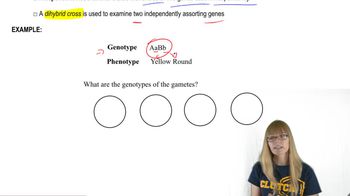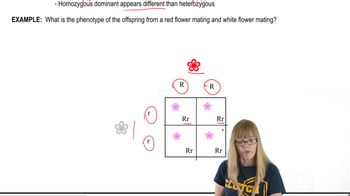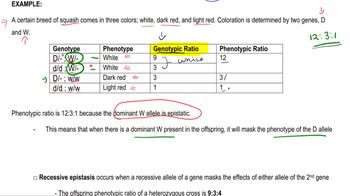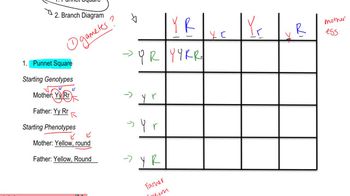- 1. Introduction to Genetics51m
- 2. Mendel's Laws of Inheritance3h 37m
- 3. Extensions to Mendelian Inheritance2h 41m
- 4. Genetic Mapping and Linkage2h 28m
- 5. Genetics of Bacteria and Viruses1h 21m
- 6. Chromosomal Variation1h 48m
- 7. DNA and Chromosome Structure56m
- 8. DNA Replication1h 10m
- 9. Mitosis and Meiosis1h 34m
- 10. Transcription1h 0m
- 11. Translation58m
- 12. Gene Regulation in Prokaryotes1h 19m
- 13. Gene Regulation in Eukaryotes44m
- 14. Genetic Control of Development44m
- 15. Genomes and Genomics1h 50m
- 16. Transposable Elements47m
- 17. Mutation, Repair, and Recombination1h 6m
- 18. Molecular Genetic Tools19m
- 19. Cancer Genetics29m
- 20. Quantitative Genetics1h 26m
- 21. Population Genetics50m
- 22. Evolutionary Genetics29m
2. Mendel's Laws of Inheritance
Dihybrid Cross
Problem 17d
Textbook Question
In rats, the following genotypes of two independently assorting autosomal genes determine coat color: A— B— (gray) A — bb. (yellow) aaB— (black) aabb (cream) A third gene pair on a separate autosome determines whether or not any color will be produced. The CC and Cc genotypes allow color according to the expression of the A and B alleles. However, the cc genotype results in albino rats regardless of the A and B alleles present. Determine the F₁ phenotypic ratio of the following crosses: AAbbCC×aaBBcc
 Verified step by step guidance
Verified step by step guidance1
Identify the genotypes of the parents: AAbbCC and aaBBcc.
Determine the gametes produced by each parent. AAbbCC can produce gametes with AbC, and aaBBcc can produce gametes with aBc.
Perform a Punnett square to determine the F₁ genotypes by combining the gametes from each parent. Each offspring will have the genotype AaBbCc.
Analyze the effect of the C gene. Since all F₁ offspring have the Cc genotype, they will express color according to the A and B alleles.
Determine the phenotypic expression of the F₁ generation. With AaBbCc, the phenotype will be gray, as the presence of A— B— allows for gray coat color.
Recommended similar problem, with video answer:
 Verified Solution
Verified SolutionThis video solution was recommended by our tutors as helpful for the problem above
Video duration:
4mPlay a video:
Was this helpful?
Key Concepts
Here are the essential concepts you must grasp in order to answer the question correctly.
Independent Assortment
Independent assortment is a fundamental principle of genetics stating that alleles for different genes segregate independently of one another during gamete formation. This means that the inheritance of one trait will not affect the inheritance of another, allowing for a variety of combinations in offspring. Understanding this concept is crucial for predicting the phenotypic ratios resulting from genetic crosses.
Recommended video:
Guided course

Gamete Genetics and Independent Assortment
Dominant and Recessive Alleles
In genetics, alleles can be classified as dominant or recessive. Dominant alleles mask the expression of recessive alleles in heterozygous conditions. In the context of the question, the presence of dominant alleles (A or B) will determine the coat color phenotype, while recessive alleles (a or b) will only express their traits when homozygous.
Recommended video:
Guided course

Variations on Dominance
Epistasis
Epistasis occurs when the expression of one gene is affected by one or more other genes. In this scenario, the presence of the cc genotype inhibits the expression of the A and B alleles, resulting in an albino phenotype regardless of the coat color alleles. Recognizing epistatic interactions is essential for accurately determining phenotypic ratios in genetic crosses.
Recommended video:
Guided course

Epistatic Genes
Related Videos
Related Practice





